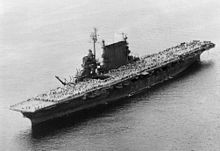- Operation Magic Carpet
-
This article is about the United States post-World War II operation. For the Israeli operation to transport Yemenite Jews to Israel, see Operation Magic Carpet (Yemen).
 Homeward bound U.S. GIs on board the carrier USS Enterprise during Operation "Magic Carpet"
Homeward bound U.S. GIs on board the carrier USS Enterprise during Operation "Magic Carpet"
Operation Magic Carpet was the post-World War II effort by the War Shipping Administration to repatriate over eight million American military personnel from the European, Pacific, and CBI theaters. Hundreds of Liberty ships, Victory ships, and troop transports began repatriating soldiers from Europe in June 1945. Beginning in October 1945, over 370 Navy ships were used for repatriation duties in the Pacific. Warships, such as Aircraft carriers, battleships, hospital ships, and large numbers of assault transports were used. The European phase of Operation "Magic Carpet" concluded in February 1946 while the Pacific phase continued until September 1946.
Contents
Planning
As early as mid-1943, the US Army had recognized that, once victory was won, bringing the troops home would be a priority. More than 16 million Americans were in uniform; and more than eight million of them were scattered across 55 theaters of war worldwide. Army Chief of Staff General George Marshall established committees to address the logistical problem. Eventually organization of the operation was given to the War Shipping Administration.[1]
Europe
The navy was excluded from the initial European sealift, as the Pacific War was far from over, and the task of returning the troops was the sole responsibility of the army and Merchant Marine. The WSA ordered the immediate conversion of 300 Liberty and Victory cargo ships into transports. Adequate port and docking facilities were also serious considerations along with the transportation necessary to take the veterans to demobilization camps after they reached America's shores.[1]
The first homeward-bound ships left Europe in late June 1945, and by November, the sealift was at its height. Whereas American shipping had averaged the delivery of 148,000 soldiers per month to the ETO during the wartime build-up, the post VE-Day rush homeward would average more than 435,000 GIs per month for the next 14 months.[2]
In mid-October 1945 the US Navy donated the newly-commissioned carrier Lake Champlain (CV-39) - fitted with bunks for 3,300 troops - to the operation. She was joined in November by the battleship Washington (BB-56). The European lift now included more than 400 vessels. Some would carry as few as 300 while the large liners often squeezed 15,000 aboard.[2] The WSA and the army also converted 29 troopships into special carriers for war brides, for the almost half a million European women who had married American GIs.[3] The "Magic Carpet" fleet also included 48 hospital ships; these transported more than half a million wounded.[2]
Nor was this a one-way stream. Returned to Europe were more than 450,000 German prisoners of war, in addition to 53,000 Italian ex-POWs.[3]
Between May and September 1945, 1,417,850 were repatriated. Between October 1945 to April 1946, another 3,323,395. By the end of February, the ETO phase of "Magic Carpet" was essentially completed.[3]
Pacific
 A total of 29,204 servicemen returned aboard USS Saratoga (CV-3), more than on any other individual ship.
A total of 29,204 servicemen returned aboard USS Saratoga (CV-3), more than on any other individual ship.
With the surrender of Japan, the navy also began bringing home sailors and marines. Vice Admiral Forrest Sherman's Task Force 11 departed Tokyo Bay early in September 1945 with the battleships New Mexico (BB-40), Idaho (BB-42), Mississippi (BB-41), and North Carolina (BB-55), and two carriers plus a squadron of destroyers filled with homeward-bound servicemen. Stopping at Okinawa, they embarked thousands more Tenth United States Army troops.[3]
The navy hastily converted many of its warships into temporary transports, including aircraft carriers, where three-to five-tiered bunks were installed on the hangar decks to provide accommodation for several thousand men in relative comfort. The navy fleet of 369 ships included 222 assault transports, 6 battleships, 18 cruisers, 57 aircraft carriers and 12 hospital ships.[4]
By October 1945, "Magic Carpet" was operating worldwide with the army, navy and WSA pooling their resources to expedite the troop-lift. December 1945 became the peak month with almost 700,000 returning home from the Pacific. With the final arrival of 29 troop transports carrying more than 200,000 soldiers and sailors from the China-Burma-India theater in April 1946, Operation "Magic Carpet" came to its end. The last of the troops to return from the Pacific war zone (127,300) would arrive home in September 1946.[4]
Airlift
The army's Air Transport Command (ATC) and the navy's Naval Air Transport Service (NATS) were also involved in "Magic Carpet" operations, amassing millions of flying hours in transport and cargo aircraft, though the total number of personnel returned home by aircraft was tiny in comparison to the numbers carried by ship.[3]
References
- Notes
- Bibliography
- Gault, Owen (September 2005). "Operation Magic Carpet". Sea Classics (Chatsworth: Challenge Publications). http://findarticles.com/p/articles/mi_qa4442/is_200509/ai_n16064642/. Retrieved 13 September 2009.
Categories:- Non-combat military operations involving the United States
- United States Marine Corps in the 20th century
Wikimedia Foundation. 2010.
